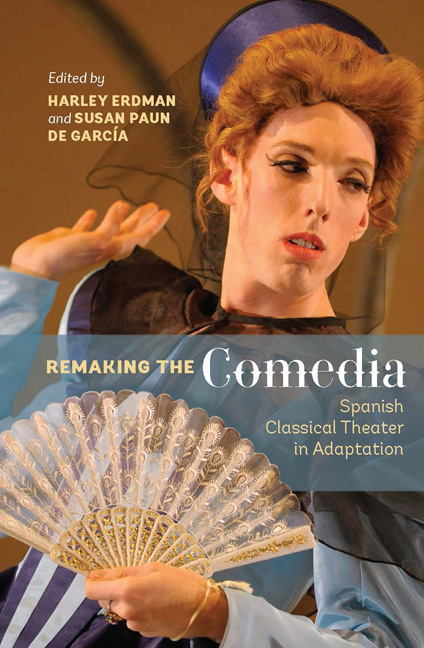Book contents
- Frontmatter
- Contents
- Illustrations
- Contributors
- Preface
- Note to the Reader
- Acknowledgements
- PART I THEORIZING
- PART II SURVEYING
- PART III SPOTLIGHTING
- PART IV SHIFTING
- 21 Porous Boundaries: novela or comedia?
- 22 Lope de Vega and Lenfilm: The Dog in the Manger's Cross-Cultural Journey
- 23 Classical Theater and Puppetry: La Máquina Real
- 24 Remaking Moreto's El desdén con el desdén: From Author's Text to Director's Text
- 25 Lope's Peribáñez on the Lyric Stage
- 26 A Musical Marta
- Play Titles Cited
- Works Cited
- Index
26 - A Musical Marta
from PART IV - SHIFTING
Published online by Cambridge University Press: 05 December 2015
- Frontmatter
- Contents
- Illustrations
- Contributors
- Preface
- Note to the Reader
- Acknowledgements
- PART I THEORIZING
- PART II SURVEYING
- PART III SPOTLIGHTING
- PART IV SHIFTING
- 21 Porous Boundaries: novela or comedia?
- 22 Lope de Vega and Lenfilm: The Dog in the Manger's Cross-Cultural Journey
- 23 Classical Theater and Puppetry: La Máquina Real
- 24 Remaking Moreto's El desdén con el desdén: From Author's Text to Director's Text
- 25 Lope's Peribáñez on the Lyric Stage
- 26 A Musical Marta
- Play Titles Cited
- Works Cited
- Index
Summary
Marta la piadosa has been among the most popular of Tirso's plays over the last fifty years. While it is true that in our time—and, one might add, in any other time—Don Gil de las calzas verdes and El vergonzoso en palacio have been the Mercedarian's comedies par excellence, Marta has been aside from these possibly his most frequently edited comic work; it has received particular attention from critics and, on occasion, has made it to the stage or earned the honor of a Radio Nacional de España recording.
In spite of this, the only professional staging in our time presented as part of a company's regular theatrical season was the production directed by Alberto González Vergel for Madrid's Español company (then, the national theater). Although its premiere is commonly given as december 5, 1973, when it was presented in the company's home venue, the production was performed in Toledo as early as June 29 of that year as part of the Festivales de España program. As a summer production, on temporary outdoor stages, with impressive monuments as backdrop, it toured huelva, Cáceres, plasencia, Teruel, and Barcelona (“Estreno de Marta”). In Madrid, the run lasted until June 2, 1974. In total, it was on the boards for eleven months, seven of them in the company's home venue in Madrid.
It was presented to the public as a rock spectacle, whose genealogy, as Eduardo G. Rico has pointed out, can be traced to international hits such as Jesus Christ Superstar, Godspell, Hair, and Oh Calcutta! Although no one has noted it, the then-current vogue for Brechtian theater also probably exerted a strong influence, with songs that serve as distancing devices and spaces left for the spectators' reflection. To a certain extent, Capmany's Marta both imitated and parodied this dramatic system.
The staging and the music, created and performed by the group Célula, complemented Sandra lebrock's ballet, which at times turned into a pantomime representing moments from the drama.
- Type
- Chapter
- Information
- Remaking the ComediaSpanish Classical Theater in Adaptation, pp. 255 - 264Publisher: Boydell & BrewerPrint publication year: 2015

